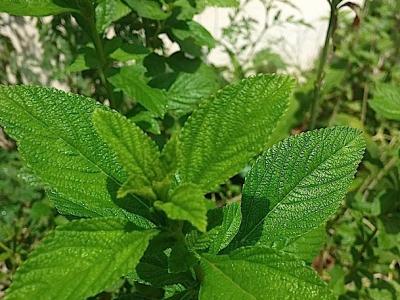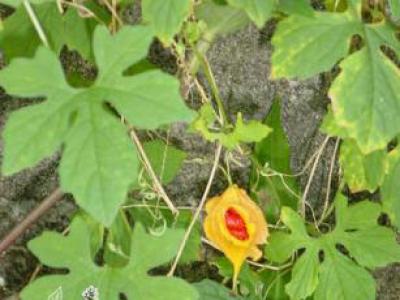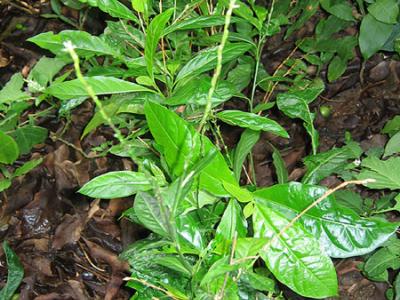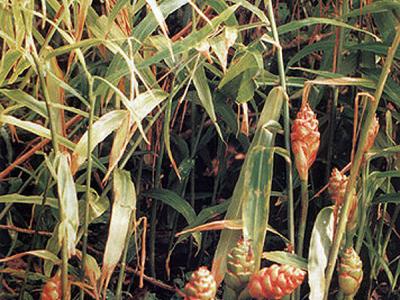(dans les territoires avec usage significatif TRAMIL)
Saint-Martin:
- mant
Martinique:
- mant
Guadeloupe:
- mant
- mant
Dominique:
- peppermint
Cuba:
- toronjil
- toronjil de menta
Panama:
- yerba buena
Vénézuéla:
- yerba buena
feuille, décoction ou infusion, voie orale7-9
Selon l’information disponible :
L’emploi contre la diarrhée, les maux d’estomac, la flatulence, l’indigestion, la grippe, le rhume et les vomissements est classé REC sur la base de l’usage significatif traditionnel documenté par les enquêtes TRAMIL, les études de toxicité et l’information scientifique publiée.
En cas de diarrhée, ce remède est considéré comme complémentaire de la thérapie de réhydratation orale.
Si on observe chez le patient atteint de diarrhée une déshydratation avec langue sèche, pli cutané persistant, oligurie ou pleurs sans larmes, consulter un médecin immédiatement. Si la diarrhée dure plus de 3 jours chez un adulte ou plus d’un jour chez un enfant, consulter un médecin.
Si l’état du patient se détériore, ou si les maux d’estomac ou l’indigestion durent plus de 3 jours, la grippe plus de 7 jours ou encore si les vomissements persistent au-delà de 2 jours, consulter un médecin.
Eviter son ingestion en cas d’affections de la vésicule biliaire, de calculs10 et en cas de prise de médicaments antiacides ou réduisant le pH stomacal comme les inhibiteurs de protons à cause du risque d’interaction11.
Ne pas employer avec des femmes enceintes ou allaitantes, ni avec des enfants de moins de 5 ans.
La feuille de Mentha spicata est un condiment de consommation humaine relativement répandue et Mentha piperita constitue une source industrielle d’huile essentielle.
Contre les douleurs d’estomac :
Préparer une infusion en ajoutant 1 tasse (250 millilitres) d’eau bouillante à 10-15 grammes de feuilles. Couvrir le récipient, laisser reposer 5 minutes et filtrer.
Contre la diarrhée, la flatulence, l’indigestion, la grippe, le rhume ou les vomissements :
Préparer une décoction ou une infusion avec 10-15 grammes de feuilles dans 1 tasse (250 millilitres) d’eau. Pour la décoction, faire bouillir 5 minutes dans un récipient couvert. Pour l’infusion, ajouter l’eau bouillante aux 10-15 grammes de feuilles et couvrir le récipient. Laisser reposer 5 minutes et filtrer.
Dans tous les cas, boire 1 tasse 2-4 fois par jour, ou prendre 1 tasse aux moments requis par l’indication symptomatique35-36.
Toute préparation médicinale doit être conservée au froid et utilisée dans les 24 heures.
1 DELENS M, 1990-92
Encuesta TRAMIL. Centro al Servicio de la Acción Popular CESAP, Caracas, Venezuela.
2 CARBALLO A, 1990
Encuesta TRAMIL. Centro de investigación de fitoterapia y medicina tradicional de Topes de Collantes, Trinidad, Cuba.
3 CHARLES C, 1988
TRAMIL survey. Movement for Cultural Awareness MCA, Roseau, Dominica.
4 EDOUARD JA, 1992
Enquête TRAMIL. Lycée agricole, Baie-Mahault, Guadeloupe.
5 BALZ E, BOYER A, BURAUD M, 2007
Enquête TRAMIL à Marie-Galante. U. Bordeaux 3, U. Paris XI Chatenay-Malabry, UAG, Guadeloupe.
6 BOULOGNE Isabelle, 2009
Enquête TRAMIL, (Terre-de-Bas et Terre-de-Haut) Les Saintes, UAG, Guadeloupe.
7 OCRISSE G, 2008
Enquête TRAMIL auprès de 250 familles de la moitié Est de la partie francophone de St Martin. Biologie végétale, UAG, Guadeloupe.
8 LONGUEFOSSE JL, NOSSIN E, 1990-95
Enquête TRAMIL. Association pour la valorisation des plantes médicinales de la Caraïbe AVPMC, Fort de France, Martinique.
9 SOLIS P, CORREA M, GUPTA M, 1995
Encuesta TRAMIL (Comunidades afro-caribeñas). Centro de Investigaciones Farmacognósticas de la Flora Panameña CIFLORPAN, Facultad de Farmacia, Universidad de Panamá, Panamá, Panamá.
10 CANIGUERAL S, VILA R, RISCO E, PEREZ F, PORTILLO A, FREIXA B, MILO B, VANACLOCHA B, RIOS JL, MORALES MA, ALONSO JR, BACHILLER LI, PERIS JB, STUBING G, 2002
Mentha sp. Vademecum de Fitoterapia, Editorial Masson, Barcelona, España, Nov. 20, 2003. URL: www.masson.es/book/fitoterapia.html
11 KRAPP K, LONGE J, 2005
Enciclopedia de las Medicinas Alternativas. Editorial Océano, Barcelona, pp:1017-1021.
12 TAYLOR BA, DUTHIE HL, LUSCOMBE DK, 1985
Mechanism by which peppermint oil exerts its relaxant effect on gastrointestinal smooth muscle. J Pharm Pharmacol 37(Suppl):104.
13 GUEDON DJ, PASQUIER BP, 1994
Analysis and distribution of flavonoid glycosides and rosmarinic acid in 40 Mentha x piperita clones. J Agr Food Chem 42(3):679-684.
14 HERRMANN EC, KUCERA LS, 1967
Antiviral substances in plants of the mint family (Labiatae). 3. Peppermint (Mentha piperita) and other mint plants. Proc Soc Exp Biol Med 124(3):874-878.
15 KIUCHI F, NAKAMURA N, MIYASHITA N, NISHIZAWA S, TSUDA Y, KONDO K, 1989
Nematocidal activity of some anthelmintic traditional medicines and spices by a new assay method using larvae of Toxocara canis. Shoyakugaku Zasshi 43(4):279-287.
16 LESLIE GB, 1978
A pharmacometric evaluation of nine bio-strath herbal remedies. Medita 8(10):3-19.
17 DELLA LOGGIA R, TUBARO A, LUNDER TL, 1990
Evaluation of some pharmacological activities of a peppermint extract. Fitoterapia 61(3):215-221.
18 DELLA LOGGIA R, TUBARO A, REDAELLI C, 1981
Valutazione dell'attività sul S.N.C. del topo di alcuni estratti vegetali e di una loro associazione. (Evaluation of the activity on the mouse CNS of several plant extracts and a combination of them). Rivista di Neurologia 51(5):297-310.
19 ARUMUGAM P, GAYATRI N, SUBATHRA M, RAMESH A, 2008
Anti-inflammatory activity of four solvent fractions of ethanol extract of Mentha spicata L. investigated on acute and chronic inflammation induced rats. Environmental Toxicology and Pharmacology 26(1):92-95.
20 COSTA M, DI STASI LC, KIRIZAWA M, MENDACOLLI SL, GOMES C, TROLIN G, 1989
Screening in mice of some medicinal plants used for analgesic purposes in the state of Sao Paulo. Part II. J Ethnopharmacol 27(1-2):25-33.
21 HARRIES N, JAMES KC, PUGH WK, 1978
Antifoaming and carminative actions of volatile oils. J Clin Pharmacol 2:171-177.
22 TADDEI I, GIACHETTI D, TADDEI E, MANTOVANI P, BIANCHI E, 1988
Spasmolytic activity of peppermint, sage and rosemary essences and their major constituents. Fitoterapia 59(6):463-468.
23 BRIGGS C, 1993
Peppermint: medicinal herb and flavouring agent. Can Pharmaceutical J 126(2):89-92.
24 DALVI SS, NADKARNI PM, PARDESI R, GUPTA KC, 1991
Effect of peppermint oil on gastric emptying in man: A preliminary study using a radiolabelled solid test meal. Indian J Physiol Pharmacol 35(3):212-214.
25 MAY B, KUNTZ HD, KIESER M, KOHLER S, 1996
Efficacy of a fixed peppermint oil/caraway oil combination in non-ulcer dyspepsia. Arzneimittel Forschung [Drug Research] 46(12):1149-1153.
26 MARTINEZ MJ, MOREJON Z, LOPEZ M, BOUCOURT E, FUENTES V, MORON F, 2005
Clases tóxicas agudas (CTA) de una decocción de hoja fresca de Mentha nemorosa Willd. Informe TRAMIL. Laboratorio Central de Farmacología, Facultad de Ciencias Médicas “Dr. Salvador Allende”, La Habana, Cuba.
27 GUERRA MJ, LOPEZ M, BOUCOURT E, FUENTES V, MORON F, 2002
Clases tóxicas agudas en rata de decocción (30%) de hojas secas de Mentha x piperita var citrata (Ehrh.) Briq. Informe TRAMIL. Laboratorio Central de Farmacología. Facultad de Medicina “Dr. Salvador Allende”, La Habana, Cuba.
28 GUERRA MJ, LOPEZ M, BOUCOURT E, FUENTES V, 2002
Toxicidad aguda (DL50) en ratón de la decocción de hojas secas de Mentha x piperita var citrata (Ehrh.) Briq. Informe TRAMIL. Laboratorio Central de Farmacología. Facultad de Medicina “Dr. Salvador Allende”, La Habana, Cuba.
29 VIZOSO A, RAMOS A, VILLAESCUSA A, DECALO M, BETANCOURT J, 1997
Estudio genotóxico in vitro e in vivo en tinturas de Melissa officinalis L. (toronjil) y Mentha piperita L. (toronjil de menta). Rev Cub Plantas Med 2(1):6-11.
30 PARRA AL, CAPO JT, MONTALVO RV, GONZALEZ YC, 1999
Toxicidad aguda oral de extractos hidroalcohólicos de plantas medicinales. Rev Cub Plantas Med 1(4):26-28.
31 MICROMEDEX T, 2003
Healthcare Series. Vol. 117. 9/2003 Thomson MICROMEDEX®.
32 BUDAVARI S (Ed.), 2001
The Merck index: an encyclopedia of chemical, drugs, and biologicals. 30th ed. New Jersey, USA: Merck and Co., Inc. p1043-1044.
33 SIVASWAMY SM, BALACHANDRAN B, BALANEHRU S, SIVARAMAKRISHNAN VM, 1991
Mutagenic activity of south Indian food items. Indian J Exp Biol 29(8):730-737.
34 CODE OF FEDERAL REGULATIONS, 2002
Food and drugs. Chapter I - Food and Drug administration, Department of Health and Human Services. Part 182 - Substances generally recognized as safe. Sec. 182.10. Spices and other natural seasonings and flavorings. U.S. Government Printing Office via GPO Access, USA. 21(3):451-452. Feb. 24, 2003, URL: www.accessdata.fda.gov/scripts/cdrh/cfdocs/cfcfr/CFRSearch.cfm?CFRPart=…
35 WICHTL M, 1999
Plantes thérapeutiques. Tec and Doc. p365.
36 ALONSO J, 1998
Tratado de fitomedicina: bases clínicas y farmacológicas. Buenos Aires, Argentina: ISIS ediciones SRL. p721.





